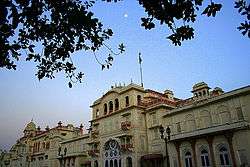Moti Bagh Palace
Moti Bagh Palace is a palace in Patiala, also known as Pearl Garden Palace. [3] The word "Moti" means "pearl", and "Bagh" means "garden".[4] The Palace was built by Maharaja Narinder Singh, the great-grandfather of Maharaja Bhupinder Singh, in 1847,[5] at a cost of five lakhs of rupees.[6] The Old Moti Bagh Palace and New Moti Bagh Palace were built respectively by Maharaja Narinder Singh (reigned 1845-62) and Maharaja Yadavindra Singh.[7][8]
| Moti Bagh Palace | |
|---|---|
 The Old Moti Bagh Palace | |
| Type | royal palace |
| Location | Patiala, Punjab, India[1] |
| Built | 1847[2] |
| Original use | Residence of the Maharaja of Patiala |
| Current use | Headquarters of the North Zone Cultural Centre; Office of the National Institute of Sports; museum. |
The Old Palace is one of the largest residencies in Asia, [9] housing the Netaji Subhas National Institute of Sports (NIS) currently.[10][11] And the New Moti Bagh Palace is the residence of Chief Minister of Punjab Captain Amarinder Singh currently.[12]
History
It was expanded in 1920s under the supervision of Sir Ganga Ram during the reign of Maharaja Bhupinder Singh. After independence, the Government of India took over the premises, and later converted it into a museum, a taxidermy gallery, and the North Zone Cultural Centre.
The National Institute of Sports (NIS) Patiala is situated in its East wing,[13] where the annual Patiala Heritage festival is celebrated.

There is another building, called the New Moti Bagh Palace, built in 1959,[14] that is residence of Amarinder Singh.[15]
Architecture
The Palace incorporates Indian and European architectural features.[16]
References
- DK Eyewitness Travel Guide: India. DK Publishing. 1 September 2011. pp. 802–. ISBN 978-0-7566-8444-0.
- The Sikh Courier. Sikh Cultural Society of Great Britain. 1977.
- K. Natwar-Singh (1998). The magnificent maharaja. Harper-Collins Publishers, India. ISBN 978-81-7223-289-4.
- Yvonne Alice Gertrude Fitz Roy; Yvonne Fitzroy (1926). Courts and Camps in India: Impressions of Viceregal Tours, 1921-1924. Methuen.
- Manjit Singh (1992). Political Socialization of Students. Deep & Deep Publications.
- Jaspreet Kaur Sandhu (2000). Sikh ethos: eighteenth century perspective. Vision & Venture. ISBN 978-81-86769-12-6.
- Trisha Gupta.Experience the old-world charm at one of Patiala's regal residences, The Baradari Palace.Outlook (Indian magazine).September 10 , 2014.
- Outlook Publishing (November 2008). Outlook Traveller. Outlook Publishing. pp. 20–.
- George Michell; Philip H. Davies (1989). The Penguin Guide to the Monuments of India: Islamic, Rajput, European. Viking.
- Disvoer Punajb. Parminder Singh Grover. pp. 146–. GGKEY:LDGC4W6XWEX.
- High Definition Books. UGC-NET/SET: Physical Education (Paper II & III) JRF and Assistant Professor Exam Guide: UGC NET Physical education. High Definition Books. pp. 158–. GGKEY:UA1T1393YEU.
- Vishal Rambani.Holi, Diwali come together at New Moti Bagh palace in Patiala.Hindustan Times Mar 12, 2017.
- "About us". National Institute of Sports. Retrieved 13 August 2014.
- George Michell; Philip H. Davies (1989). Guide to Monuments of India 2: 2islamic, Rajput, European. Viking. ISBN 978-0-670-80847-2.
- Mohinder Singh (1 January 2001). Punjab 2000: political and socio-economic developments. Anamika Publishers & Distributors. ISBN 978-81-86565-90-2.
- Jane Shadel Spillman (2006). European glass furnishings for Eastern palaces. Corning Museum of Glass.
External links
| Wikimedia Commons has media related to New Moti Bagh Palace. |
| Wikimedia Commons has media related to Old Moti Bagh Palace. |